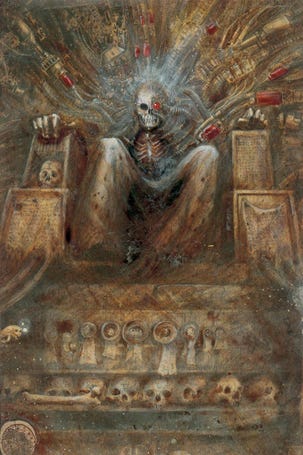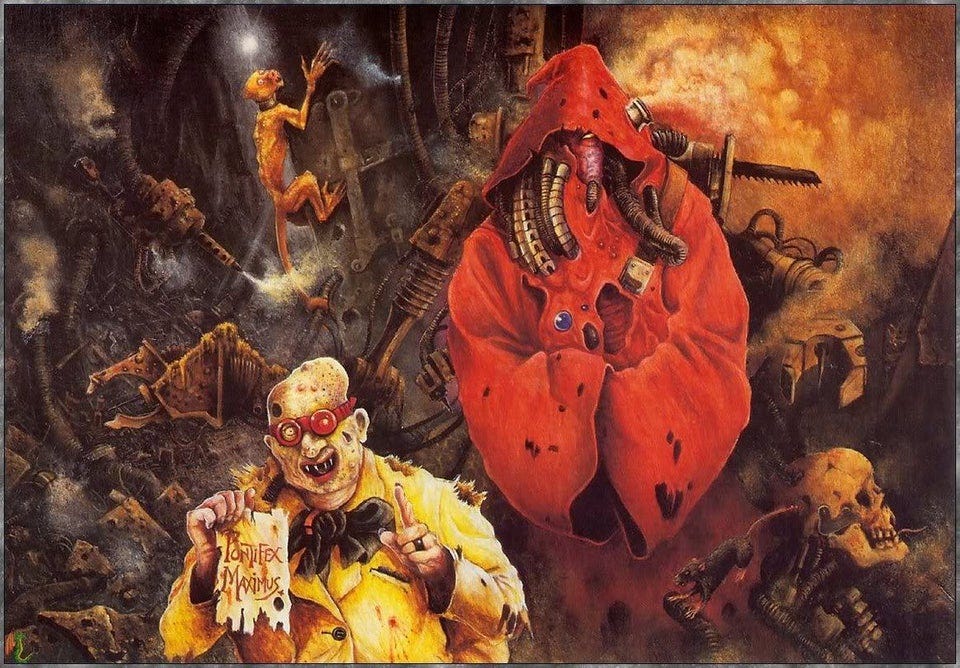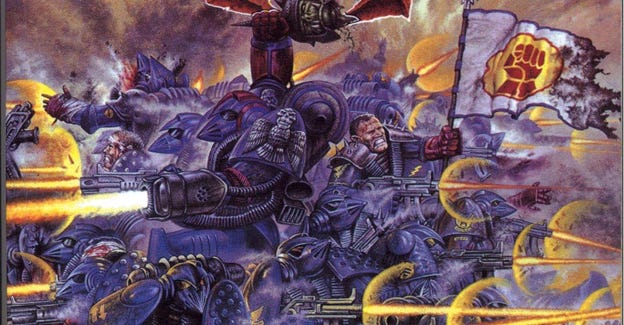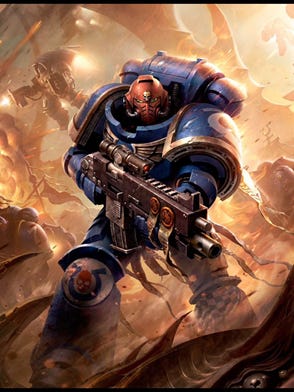The Leftist Case for Warhammer 40,000
In which we discuss the political history of a troubled game.
Sometime around late 2015, as the reality of Donald Trump’s candidacy began to sink in, a series of memes spread depicting Donald Trump as the God-Emperor from Games Workshop’s iconic game setting, Warhammer 40,000.
In the game, the God-Emperor is an ancient, undying superhuman and abusive father. The art above depicts him during his heyday, in a period prior to the game people usually play, when he was carrying out a galactic genocide Hitler would’ve called “extra”. In fact this portrait of him is set literal seconds before he was brutally mauled by his eldest son and left in a near-vegetative state. As things “currently” stand in-game, he’s hooked up to a city-sized ICU bed that has to be fed the souls of a thousand children every day in order to remain active.
It’s actually a decent allegory for the way power functions in society, the vibrancy of the young and poor used to sustain a sclerotic, largely unaware but all-consuming ruling elite. Art depicting the ‘modern-day’ emperor would function just as well if repurposed as anarchist political cartoons.
This piece of art is by the great John Blanche, perhaps the very best games illustrator alive today and an absolute icon in his field. For some reason, his work rarely shows up in the right-wing memes. It’s a shame. They’re missing some real bangers.
I spent hours staring at this exact picture in the late 1990s, desperately trying to figure out what in the game John was attempting to depict here. Decades later, I’d be struck by how well John’s work seems to capture the attitude of an ISIS fighter posing for a picture.
John’s work is almost psychedelic in its weirdness, it was an incredibly cool thing to set in front of a 12-year-old raised by Reagan Republicans. But I’m not surprised it loses out in the meme-wars to shit like that first picture of the Emperor, which in 2019 found its way to the head of an Italian carnival parade:



Good-hearted fans of the game often say that fascists who repurpose art idolizing the God-Emperor are ‘missing the point’. Warhammer’s roots are, as documented in this wonderful article (and this pretty good one), definitively leftist. One of the earliest Warhammer Fantasy supplements was an extended reference to the 1984-1985 miner’s strike. Orcs, described as “repulsive monsters who live to inflict pain”, initially fought under a banner depicting Margaret Thatcher.
Games Workshop was founded in 1975 by three guys who actually have relatively little to do with Warhammer itself. They were games nerds, and one of them left early on when it became clear that his partners were more interested in “progressive games” (stuff like Dungeons & Dragons and early computer RPGs) than backgammon. The company stayed afloat, and eventually thrived, when it won the official UK distribution rights to Dungeons & Dragons and Runequest.
Early GW shotgunned this first wave of nerd games out into Europe at a rapid pace, which helped fund fund a series of experimental wargames and role playing settings that eventually brought us Warhammer Fantasy Battles. This period, from the late 1970s through the mid-1980s, was the heyday for weird leftist politics in Games Workshop products.
Early Warhammer deserves credit for being progressive in a number of ways. While it did feature plenty of the same tired pop fantasy trends, it has also been noted for its prevalence of strong female characters. Zhu Bajiee, who has done the absolute best writing on this subject, notes:
“The text in Forces of Fantasy makes it explicit: “Dark Elf soldiery is as likely to be female as male; Elf maidens are as cruel and murderous as their menfolk.” This aspect of gender equality, in both text and image, radically subverts established conventions of the fantasy genre. While there are certainly examples of cheesecake or pin-up art, these tend to be non-warrior types such as magic-users. In the early Warhammer oeuvre, the transformation of the Dark Elf from sexy dominatrix to serious combatant is a departure that establishes a tone of equality in terms of representation and ability.”
There were anti-colonial themes in early Warhammer Fantasy supplements, and the heroes were more likely to be depicted as punks and vagrants than defenders of Empire. This is in keeping with the working class backgrounds of many early GW designers. Tony Ackland, who basically created GW’s Dark Elves, was raised by his mother who worked in the pottery industry. John Blanche, famed for his distaste of “pin-up” style drawings of female fantasy characters, was raised on a Council estate in the 1950s. He describes it as “grey and flat”, which helped inspire some of the setting’s most iconic art.
As the 80s churned along, Games Workshop lost the distribution rights to D&D, so they pivoted hard in favor of the weird little wargames that formed an increasing share of their profits. Warhammer 40,000: Rogue Trader was released in October of 1987. The game was initially a big glorious pastiche of every great work of contemporary sci-fi and fantasy. The Space Marines were heavily influenced by the novel Starship Troopers. There were bits of Star Wars, heavy chunks of Dune, and a dollop or two of Tolkien, all rounded out by (one presumes) piles of cocaine taller than Big Ben.
There were still bits and pieces of leftist imagery, but the female protagonists and extended labor metaphors faded away. The defining characters of Games Workshop games morphed from socialist Dwarf miners and Thatcherite Orcs to the now-iconic Space Marines.
(The Space Marines are the guys in the upper left, not the dude manning the mortar who was clearly based on Fidel Castro.)
In the ‘fluff’ (in-universe story) Space Marines are literal child-soldiers, taken from their families and surgically mutilated to become post-human warriors. In the more self-aware background fiction, they evoke both Ottoman Janissaries and the Children’s Crusade in equal measure. But most Warhammer fiction is not particularly self-aware, and over time the popularity of these models led to ‘fluff’ that was less tongue-and-cheek and more a celebration of how cool Space Marines were.
This change happened mostly from the late 1990s to the early 2000s. In Second Edition Warhammer, where I started playing, there were still hints of radicalism. This art, which was featured on the 40k rulebook, is probably the first piece of Warhammer art I ever saw:
It’s a clear visual reference to the British Empire’s most infamous propaganda art, depicting the disastrous battle of Isandlwana during the Zulu War:
The Space Marines are depicted as struggling, overwhelmed colonial soldiers, thrown into a hopeless slaughter by the careless machinations of their distant overlords. Compare that to this piece of Third Edition artwork, by John Blanche, from just a few years later:
Superficially, this is a very similar piece. But the Space Marines lack any sense of desperation or vulnerability. Much of the grit has been replaced by Cool Guys Posing With Guns. Of course, this is still a John Blanche piece, and it looks undeniably good. But as the years went by, more and more Games Workshop art left the grit behind in favor of stuff like this:
And this…
Warhammer 40,000 is still, at some level, a chilling depiction of a galactic fascist regime, propped up by mutilated child soldiers who enforce a racial supremacist hierarchy via genocide. But it’s easy to miss that in favor of celebrating how badass your favorite Chapter or warrior happens to appear. This brings us back to the memes.
There’s, unfortunately, an awful lot going on here. The quote above the image is from Julius Evola, a fascist mystic who found Mussolini’s politics “too compromising” and eventually took a job working as a spy for the Nazis. After the war he became a deeply influential right-wing occult guru whose work pops up whenever weird groups of Nazis gather to plan terrorist attacks.
In the actual meme, the guys on the bottom are demons of the Chaos gods. To these right wing weirdos they represent degeneracy. The concept for Chaos in Warhammer 40k is basically stolen wholesale from the work of Michael Moorcock. His Chaos gods were neither good nor evil, and in fact they often wound up fighting against the most toxic aspects of the gods who represent Law. Moorcock’s fiction is heavily anarchist, and the Chaos symbol he created can be found on many works of anarchist political theory today.
A good example of this would be the AK Press collection ‘No Gods, No Masters’, which is the first book of anarchist political theory I ever bought.
Today, depiction of Chaos in Warhammer fiction varies widely. Games Workshop is generally smart enough to give their fiction writers a pretty loose hand. If you read novels from their publishing arm, Black Library, you’re as likely to come across hard-nosed military sci-fi about the brutal human cost of war and the staggering incompetence of Imperial Bureaucracy as you are books about how cool it is when a huge guy hits people with his giant metal hand.
Depictions of Chaos, however, rarely have much subtlety to them. The very best you’re likely to get is competent works of cosmic horror. There are some pretty cool stories to tell with Games Workshop’s Chaos, who feed off of human emotions and gradually warp reality around themselves, slowly consuming the galaxy.
Agents of Chaos tend to spread their taint by leading uprisings against Imperial power, often powered by real injustices perpetrated by corrupt Imperial governors. The fact that these dissidents are inevitably doomed by their flirtation with Chaos plays into the hands of weird fascists who see it as an allegory for their revolt against Satanic Marxists. Art like this doesn’t exactly help.
Of course, the fluff is rather more muddled then that. The Emperor himself, back before he wound up in that ICU bed, was on a quest to eradicate the concept of religion from the human soul. This was part of his plan to starve the Chaos gods and save the galaxy for homo sapiens. Everything he did, the child soldiers and interstellar genocide, was to advance this end.
It failed disastrously, of course, and there are several dozen books you can read if you’d like to know more. But the consistent depiction of Chaos as The Worst Thing Ever has led a lot of otherwise well-meaning fans to wonder if the Emperor wasn’t right all along.
I find this interesting, because the bulk of Games Workshop’s fiction depicts the Emperor as an abusive father and a superpowered fascist psychopath, whose arrogance doomed himself and humanity to ten thousand years of the worst government imaginable. Every single book published in the Warhammer 40,000 universe starts with these words.
Over the decades, and all the many changes Warhammer 40,000 has seen, one thing has remained consistent. The Imperium of Man is “the cruelest and most bloody regime imaginable”. The only end result of fascism is suffering and failure, no matter how many cool chainsaw swords come with it.





















Robert got each of us what we needed for Christmas most, an article to distract us from the holidays. Chaos gods bless us everyone.
Great article about something you're obviously passionate about, I love your style of writing. You would KILL it if you wrote for Warhammer show.